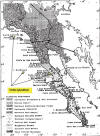|
Niebla infundibula
is a rare lichen known from Isla Guadalupe, San Nicolas Island,
and the main peninsula of Baja California along mountain ridges in the southern
part of the Northern Vizcaíno Desert. With exception to
N. homaleoides, this species is distinguished from other Niebla
species by its
rigidity rather than by specific morphological features. It is much like N. juncosa
var. juncosa, from which it differs by the branchlets
apparently not easily detaching, despite the appearance of fringed branchlets
along the main branch. This is further evident in the thallus not falling
apart when pressed for storage in the herbarium.
Niebla infundibula
has a relatively thick glossy cortex that might explain its rigidity;
yet, its thickness of 75–125
µm
is within the range of the California species
N. homalea, 75–150
µm; however, the weight of a specimen is noticeably much more. Undoubtedly this difference has to do with density of the cortical matrix. I recall Mason Hale bouncing
a specimen of N. infundibula
in his hand, while commenting
on how "massive" it was. Niebla homalea differs
from N. infundibula in the branches that regularly twist and crack
transversely. The presence
of ripples in the cortex in some specimens of N. infundibula may suggest
N. eburnea, but the cortex
of
that species is less polished, while also differs in its branchlets developing
more on
the upper part of the thallus.
The type collection has
the largest apothecia and pycnidia in the genus. However, variation in the
presence vs. absence of
apothecia, and differences in thallus size are not easily defined due to a
great deal of variation within and among species of Niebla. The
epithet, infundibula, was chosen for the funnel-form shape of the main
branch.
The
original (type) collection came from south of El Marrón on volcanic rocks, piled above
the main ridge line, ~500 m elevation; other peaks in the area were indicated on maps to
reach nearly 900 m. Oceanic ridges in this area were not easily accessible,
and had been observed in previous years to have fog lingering for much of
the day. In 1985, we
had tried to reach the fog area by hiking west from
the Santa Rosalillita-Punta Prieta Road, but then found the distance was too much for one day.
The next year we discovered an old track (not on any map) south of Punta Prieta that
terminated near the base of a mountain where we also felt more secure about leaving our vehicles. We then hiked west up a
slope to the ridge to where we were able to see the ocean. Niebla
thalli
were lush all along the ridge and slopes. Marin and McCloud went off to take pictures
while Spjut collected lichens. Towards the end of the day, Spjut
came across a large
rock outcropping on a very windy part of the ridge that undoubtedly received
more than average
moisture from the oceanic advection atmosphere. Marin assisted in winding-up
the collection, upon which an attempt was being made to sort out
specimens according to species for anticancer screening, voucher specimens of
which were later named N. infundibula, N. homaleoides,
N. josecuervoi,
N. juncosa,
N. sorocarpia,
Vermilacinia paleoderma, and V. rigida. However, because the
species were not clearly understood, the samples were kept as specimens
for taxonomic studies, with exception to V. paleoderma that was
later submitted for a chemical study.
Niebla josecuervoi and N. homaleoides
were later separated from others at the type locality of N. infundibula
by their chemical constituents. Niebla juncosa and N.
sorocarpia, which have the same chemistry as that of N. infundibula (divaricatic acid)
were distinguished by their more brittle thalli, in which branches break-off
near their tips (N. juncosa), or by the aggregate apothecia on thalli
that fall apart from the base (N. sorocarpia). The type collection for N. infundibula is
distinct for its intact, rigid, heavily gelatinized thallus with relatively large
apothecia.
|




